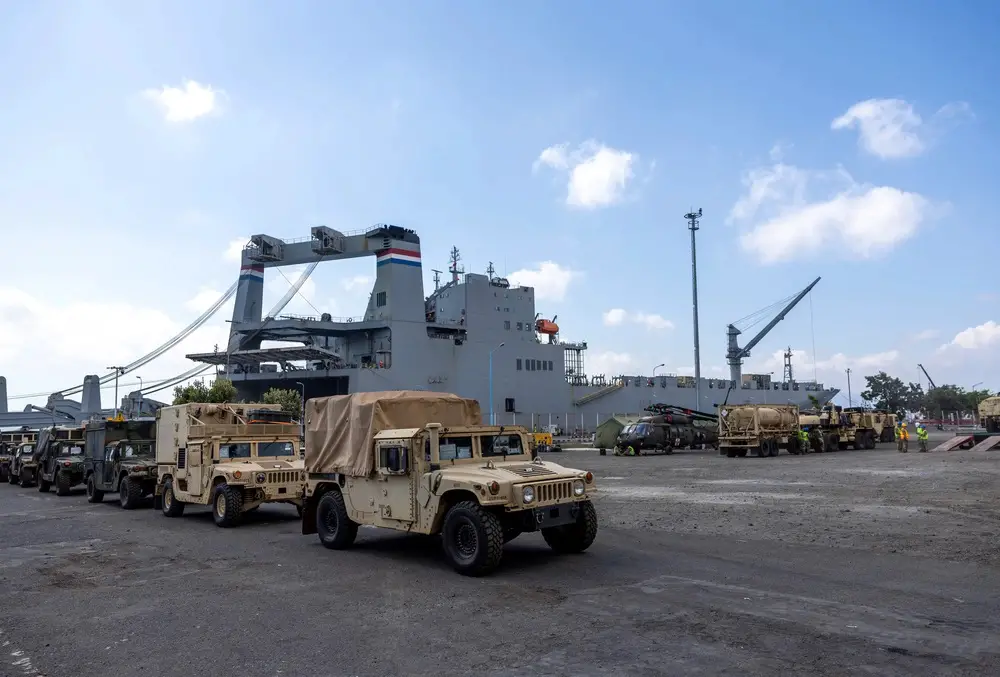Military Sealift Command (MSC) chartered Motor Vessel (MV) Cape Hudson (T-AKR 5066) arrived at the port of Banyuwangi, Indonesia, to offload equipment in support of exercise Super Garuda Shield 2024, August 12-13, 2024. The vessel embarked on its voyage from its home base in San Francisco and made stops to load cargo and personnel in Tacoma, Wash.; Honolulu; and Japan before arriving at Banyuwangi. Super Garuda Shield, one of the largest multinational exercises in the Indo-Pacific region, continues to solidify the U.S.-Indonesia Major Defense Partnership Defense Cooperation Agreement and advances cooperation in support of a free and open Indo-Pacific region. Oversight of the offload in Indonesia was conducted by a detachment of the U.S. Army’s 835th Transportation Battalion, 599th Transportation Brigade, Military Surface Deployment and Distribution Command (SDDC), out of Okinawa, Japan.
“This is not a typical commercial route. We originated from the West Coast of the United States, then Hawaii and Japan, to bring equipment and a mission set all the way to Banyuwangi, Indonesia, to support (exercise Super Garuda Shield),” said contracted mariner Benjamin Day, ship’s master, MV Cape Hudson.
“These ships are a lot different then what I’m used to. Doing this type of mission is fun because the cargo is different, you’re lashing it differently; it takes a broader skill set,” said Day, who has more than six years of experience with the Cape H-class ships. According to Day, his experience on commercial container ships differs from these types of ships and missions.
“I make sure the vessel gets from point A to point B safely and that we are in contact with higher headquarters. This involves establishing secure communications between the ship and military operations center. I also provide contested-maritime-environment training with the crew,” said Lt. j. g. Alexa Lumpkin, TACAD on Cape Hudson.

Within two days, the ship unloaded approximately 313 pieces of equipment and containers. Once the items were discharged off the ship, they were staged at the marshalling area for onward movement to the respective training area. Between the expertise of MSC, SDDC and Banyuwangi port officials, all gear was off loaded as scheduled. Cape Hudson is a 750-foot-long roll-on, roll-off container vessel with four decks of cargo space. The ship can accommodate 186,000 sq. ft. of cargo, which equates to about 4.3 acres of space that can equal roughly 38,000 tons of cargo. It is part of the Cape H-class of ships that include MVs Cape Horn and Cape Henry.Despite its massive presence, the ship’s characteristically low draft allows for this tonnage while still getting into smaller ports. This ship has a significant cargo capacity and is multimodal, making Cape Hudson ideal for the charter. According to Day, his experience on commercial container ships differs from these types of ships and missions.
Cape Hudson is part of the Ready Reserve Force fleet of vessels. The RRF is a subset of vessels within the Maritime Administration’s (MARAD) National Defense Reserve Fleet ready to support the rapid worldwide deployment of U.S. military forces. As part of the crew of Cape Hudson, MSC also assigned a tactical advisor (TACAD), whose job is to deploy on commercial chartered vessels and act as a liaison between military higher headquarters and the ship’s crew. The Navy Reserve is MSC’s manpower solution for surge mission sets, and TACADs are typically Strategic Sealift Officers (SSOs), who are warfare qualified Navy Reserve Officers with civilian Merchant Mariner credentials and military training to support the activation, operation, and sustainment of the Sealift fleet. Additionally, to support the discharge of equipment, MSC deployed a three-member Reserve-component team from various Reserve Expeditionary Port Units (EPU) in the U.S. to assist with port operations.

MV Cape Hudson (T-AKR-5066) was originally built as a commercial ship in 1979 and sold to the Wilhelmsen Line with the name Barber Taif. She has two sister ships named MV Cape Henry and MV Cape Horn. It served as a merchant ship until it was purchased by the US Department of Transportation, Maritime Administration in December 1986. On 15 August 1990, she was reactivated for Operation Desert Storm and Operation Desert Shield until 20 May 1992. She conducted anchor tests south of Angel Island, San Francisco Bay on 28 July 2007. From there it was later transferred to the Maritime Administrations Ready reserve fleet and assigned to San Francisco.
According to the MARAD website, RFF provides nearly 50 percent of government-owned surge sealift capability. MSC Far East supports the U.S. 7th Fleet and ensures approximately 50 ships in the Indo-Pacific Region are manned, trained, and equipped to deliver essential supplies, fuel, cargo, and equipment to warfighters, both at sea and on shore. U.S. 7th Fleet is the U.S. Navy’s largest forward-deployed numbered fleet and routinely interacts and operates with allies and partners in preserving a free and open Indo-Pacific region. Celebrating its 75th anniversary in 2024, MSC exists to support the joint warfighter across the full spectrum of military operations, with a workforce that includes approximately 6,000 Civil Service Mariners and 1,100 contract mariners, supported by 1,500 shore staff and 1,400 active duty and Reserve military personnel.















